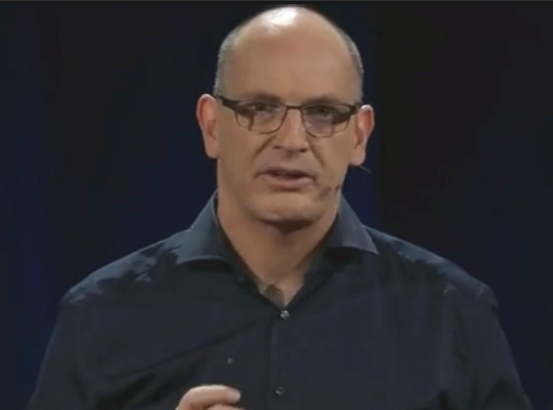So I'm banging out my story and I know it's good, and then I start to make it --
我大聲說出我的故事,我知道很好笑,為了讓故事...
Suddenly, you can see that the responses in all of the subjects lock to the story,
突然間,所有人的腦波響應都隨著故事的進展
and now they are going up and down in a very similar way across all listeners.
而上上下下,波型都很類似。
And in fact, this is exactly what is happening now in your brains when you listen to my sound speaking.
事實上,各位聽我講話的時候,這種現象也正在你的大腦里發生;
We call this effect "neural entrainment."
我們把這種現象稱為神經震蕩同步化效應。
And to explain to you what is neural entrainment, let me first explain what is physical entrainment.
為了要解釋什么是神經震蕩同步化,讓我先解釋什么是物理震蕩同步化。
So, we'll look and see five metronomes. Think of these five metronomes as five brains.
我們來看看這五個節拍器,把這五個節拍器想象成五個大腦。

And similar to the listeners before the story starts, these metronomes are going to click, but they're going to click out of phase.
如同故事開始前的五位聽者一樣,這五個節拍器會開始打拍子,但并不同步。
Now see what will happen when I connect them together by placing them on these two cylinders.
現在來看一下,當我把它們放在這兩個圓筒上,會發生什么事,
Now these two cylinders start to rotate.
兩個圓筒開始滾動了。
This rotation vibration is going through the wood and is going to couple all the metronomes together. And now listen to the click.
圓筒滾動的振動,透過木板,把所有節拍器同步在一起,聽聽看現在的滴答聲。
This is what you call physical entrainment.
這就是物理震蕩同步化。
Now let's go back to the brain and ask: What's driving this neural entrainment?
現在讓我們回到大腦,問一個問題:是什么在驅動神經震蕩同步化呢?
Is it simply the sounds that the speaker is producing?
是講者發出的聲音?
Or maybe it's the words. Or maybe it's the meaning that the speaker is trying to convey.
還是所說的字匯?還是講者想要表達的意思呢?











